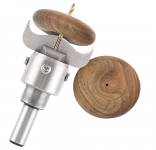I was straightening up my wood scrap pile and I had a bunch of off-cuts of 2-1/2” x 3/4” poplar. What could I make from that? Dachshunds!
My prototype is below. The wood section is 7-1/2” long by 2-1/2” tall from the top of the head to the bottom of the feet (not including the wheels).
The ears are light weight leather, hand saddle stitched to the wood through drilled holes.
The tail is the same leather hand saddle stitched to a 3/8” diameter dowel which I thinned out where the leather is stitched on. I used a utility knife to cut the fringe on the tail.
I used a small radius round over bit for the entire wood section. A larger round over bit would look good for the body, but how then to transition to a smaller bit for the face?
I’m not sure I will actually make this item. The wood is finished with shellac which is non-toxic. But is the leather non-toxic? There is no way to check.
I could switch to felt, but I think felt will tear easily—certainly more easily than leather which is easy to cut but difficult to tear.
Would a label that said, “Wooden toys are not suitable for teething children” be sufficient for that purpose? Or “For children 3 years or older”. My internet research shows that almost all children are done teething by 2-1/2 years of age.
Or drop this entirely. Or glue on wooden ears, which would alter the personality of the dog.
This also would be the most time consuming to produce of all the toys I am making.
On the other hand, I am fond of the look of this toy.
Opinions?

My prototype is below. The wood section is 7-1/2” long by 2-1/2” tall from the top of the head to the bottom of the feet (not including the wheels).
The ears are light weight leather, hand saddle stitched to the wood through drilled holes.
The tail is the same leather hand saddle stitched to a 3/8” diameter dowel which I thinned out where the leather is stitched on. I used a utility knife to cut the fringe on the tail.
I used a small radius round over bit for the entire wood section. A larger round over bit would look good for the body, but how then to transition to a smaller bit for the face?
I’m not sure I will actually make this item. The wood is finished with shellac which is non-toxic. But is the leather non-toxic? There is no way to check.
I could switch to felt, but I think felt will tear easily—certainly more easily than leather which is easy to cut but difficult to tear.
Would a label that said, “Wooden toys are not suitable for teething children” be sufficient for that purpose? Or “For children 3 years or older”. My internet research shows that almost all children are done teething by 2-1/2 years of age.
Or drop this entirely. Or glue on wooden ears, which would alter the personality of the dog.
This also would be the most time consuming to produce of all the toys I am making.
On the other hand, I am fond of the look of this toy.
Opinions?










